Originally posted on 24th June 2015, this SEO Guide is updated on 2nd July 2021 to add updated information and SEO tactics.
Attention Please! If you are really serious about SEO, sit tight and read the complete article to understand everything well. If you have got any questions after that, you can ask in the comment section.
SEO [Search Engine Optimization] is the set of strategies that are put into action to improve the visibility of websites in search engines.
On-page optimization and Off-page optimization are the two parts of SEO, and today I am here to talk about on-page optimization which is the most important part of SEO. This includes everything you do on your site to make it SEO-friendly.
On-page optimization is not a new term so you must have heard a lot about it already. If you normally say on-page SEO, people consider it as Meta tag writing and spreading keywords on the website. This is somehow true, but it is much more than just meta tags. Especially, in the age of Google’s rolling out new updates every now and then to improve user experience, On-Page optimization becomes more of optimizing your site for users than for Google’s Crawlers. In short, if your content can make the users happy, it will automatically be rewarded by Google.
On-page optimization is all of those SEO techniques that are implemented on the website, and not outside of it. So, let’s dig deeper into it.
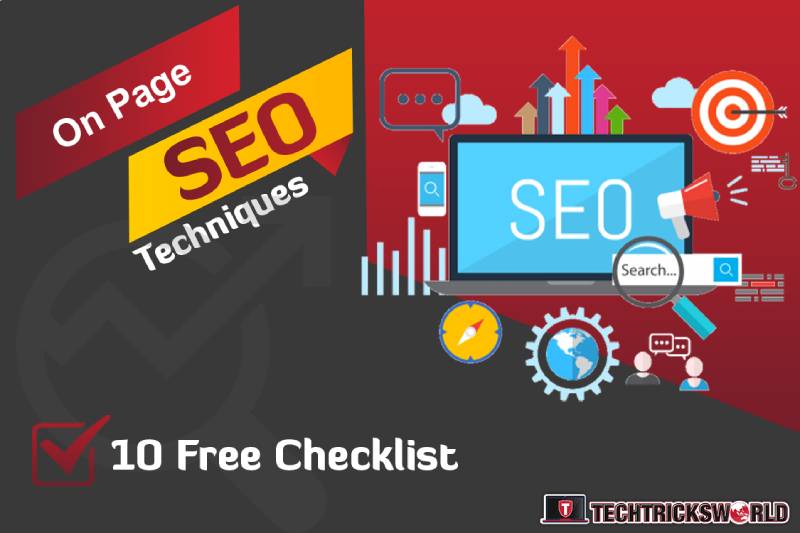
Here are the following tactics of on-page SEO explained
Note: I am explaining the on-page SEO taking blog posts into consideration. So that what you will learn, will help you optimize your blog posts or web pages.
-
SEO Friendly Permalink Structure [URL optimization]
Permalink is what comes after the main domain URL.
In the bellow screenshot, the yellow area is the permalink.
For better SEO, you should have a better permalink structure. If you are using some parameter-driven dynamic URL structure or a very long one, then take action now, and set the best permalink structure for your blog. Also, keep relevant text to build the permalink for every article. You can include one of your keywords in it to let Google know what your content is all about.
-
Title Tag
The title tag has been the most important factor of on-page optimization since the beginning of SEO. Therefore, it’s indeed important to have an SEO-friendly Title for every blog post or web page. I would like to suggest keeping meta title and post title similar [Read how to write amazing post titles]
Few checklists for better title tag:
- Relevant to the topic.
- Earlier Google was displaying 60-65 character of the title tag in the search pages but after Google’s SERP redesign, they display titles on the pixel width basis so there is no exact number which you may follow while writing title tags however, there is a tool by Moz that shows the Google SERP preview of your title. So, before publishing the post, you may check your title to see the SERP view and make it shorter if it gets long enough to go out of Google’s criteria.

- Include one of your target keywords.
- Always try to put the keyword at the beginning of the title. Don’t do it if it doesn’t look natural but if you think it looks natural then put the keyword at the beginning to get the maximum SEO benefit.
-
Meta Description
Google stopped using Meta Keywords and Meta Description as ranking factors way back in 2009. Click here to read the post in which Google announced about it.
A screenshot from the same post clearly says it all:
As written in the article that they use it to create result snippets for SERP, you should write a natural Meta description within the range of 156-160 character (space included). So that, your post’s search snippet would look good. Don’t just stuff keywords as you have just come to know that it doesn’t get you any ranking benefits but a beautiful snippet. So write a good one for your post.
-
Make use of Heading Tags [H1, H2, H3….]
H1 tags are important, and you need to use them in an SEO-friendly way. If you are not doing so, you should start doing it from today.
Use them in a sequential manner, first H1 then H2 then H3…
Give the page/post title H1 tag. WordPress CMS automatically adds H1 tag to the title so you don’t need to bother if you are a WordPress user, but if you are using a differently coded site then remember to keep the page title between <H1></H1>.
Now, within the content put the main sub-heading in <H2> and then finally put the trailing sub-domain in the <H3> tag. Don’t overdo it!
You might have read a lot that keeping keywords in the Heading tags has benefits, but let me tell you that don’t repeat it so many times rather put it once or twice in the whole article.
-
Content Optimization
Content optimization refers to the strategies you use to make your content SEO friendly. Few checklists are as:
- Write descriptive content: When you write descriptive content you are able to use keywords and semantic keywords naturally. Google also loves content that are well written with lots of facts and information. I always make sure my all post on this blog goes more than 1200-1500 words.
- Make use of Interlinking: You must not miss out on internal linking because it improves the overall linking structure of your blog, and it also helps engage your readers on the blog for longer. Read this post to learn more about Interlinking. The best example of interlinking is Wikipedia which you may look in the below screenshot:
- Sprinkle keywords naturally: Don’t stuff keywords everywhere in the article rather use it naturally that they don’t break the flow of the article.
Try to include your target keyword in the very first paragraph as search bots take reference from it to understand what the content is all about. - Write for readers not for bots: Though we are discussing on-page optimization, I would recommend you writing for readers, and not for search bots.
When you write for readers, your blog post automatically gets better, and you get more engagement which signals Google that the page is relevant and offering good user experience. Google takes this signal into consideration as well while ranking a website.
Bonus: How to Create Compelling Content That Ranks?
Creating compelling content that ranks is something you must know because just writing and publishing may not help if you do care about ranking your articles. Below are a few steps that I would advise from my personal experience:
- The very first step is to research the keywords for a particular topic. Once you find the keyword, make sure to check its Keyword Difficulty, Search Volume, and Allintitle. KD and search volume you can get from any keyword tool such as Ahrefs keyword tool. See, that KD is lower than 5 if you are working on a new site. If you are having an established site, then you can choose the KD around 10. Search Volume, you can choose accordingly. More is better but, don’t lose low search volume keywords as well if their KD is low.
Once you find out KD, and search volume, do check the allintitle of that keyword. Below 30 you can consider the low competition. To check this, you just have to do like this:

Now, since you have the keyword, make sure to dig deeper to find LSI keywords for the main keyword.
- Now, you have the keyword, and few related keywords as well. Take the main keyword, and search in Google, and see which websites are coming on top 5. Scan each of them, and collect pointers such as what they have done, and what they have missing in their article. Do the same for all 5 top results. Now, also, get each page’s word count. Do note their Titles, headings, sub-headings, and all.
- Now, you have the keywords and all the details of the top competitors for that particular keyword that you are targeting. Here is a catch, always try to choose the keywords whose top 5 competitors are not very big authority sites because outranking them becomes nearly impossible. Anyway, so, now you have all the details. This is the time to sit, and start creating the content which needs to have:
-
- The keywords you have fetched. They must be placed well as per the good on-page practice.
- The best information possible. What I mean is, you have to make sure that the information you are going to write must be better than all the 5 competitors’ content to make sure that your content is better than those. Also, try to write long enough to beat their word count as well. If that is not possible, you can anyhow write somewhere around their word count.
- Good visual content. You must include good images, videos, infographics.
- Better Internal linking and Outbound linking as well.
-
Site Loading Speed
If your site’s loading speed is great, it can offer the best user experience which is one of the ranking factors in Google’s algorithm. Yes! Google gives preference to those websites which load faster. Check your Site’s page speed, and improve if it is required. You must not avoid this.
We have been using Shared Hosting since the beginning and things were fine but, I started to feel that there is something we have to do to make the site’s loading speed even faster. Then, I moved my site to Cloud Hosting via Cloudways, and within 2 months’ time, I have started seeing a good increase in my site’s organic traffic.
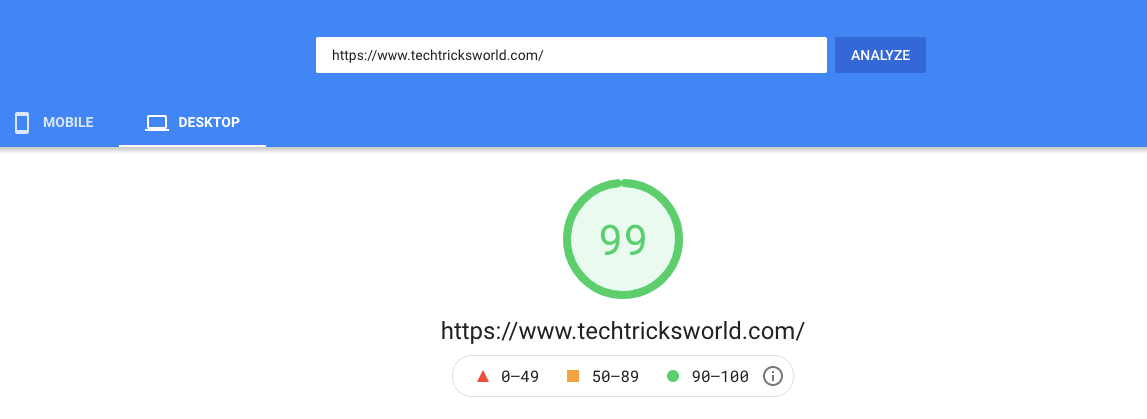
The best thing of moving to VPS was my site’s server response time increased from 1000ms to 190ms which helped increasing the site’s loading time to a great extent.
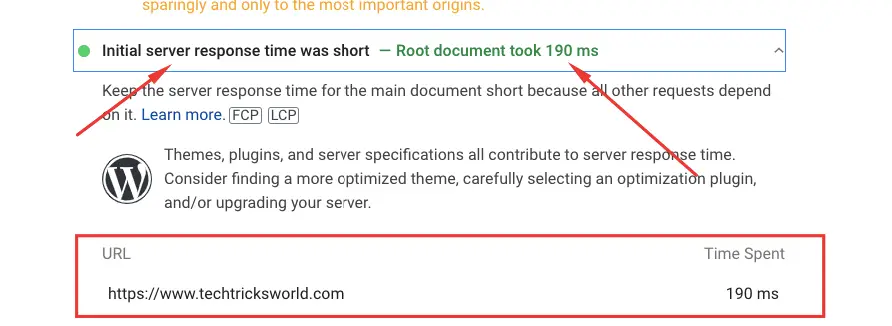
It even helped me to increase the Core Web Vitals which is one of the newest factors for getting a good ranking in Google. Although I am still optimizing my site a bit more to get all green in Core Web vitals. However, it’s been better than before after moving to VPS.
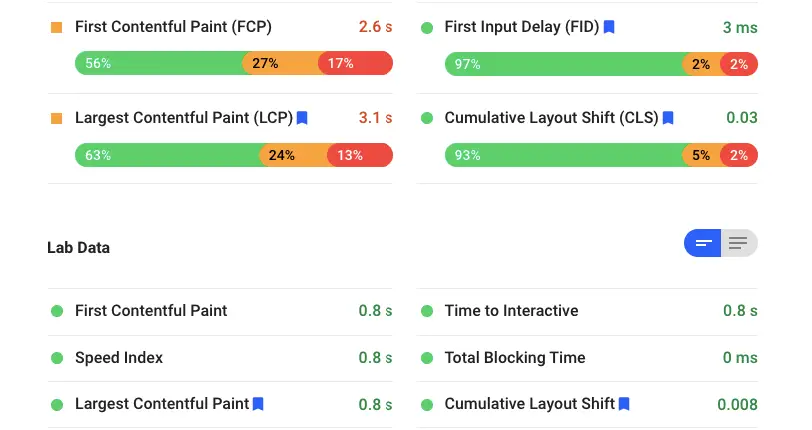
Apart from moving to VPS, we are making use of Ezoic’s Leap feature as well. Yes, since we are using Ezoic to serve ads, we are offered a tool Leap that helps improve the speed and Core Web Vitals by making adjustments to the site.
So, what I would suggest you, don’t just focus on writing and publishing but, you must take care of your site’s loading time, and all to make it the best to offer a good user experience to the viewers who visit your site.
Core Web Vitals Resources
-
Mobile Responsiveness
As the different device sizes are being used to access sites nowadays such as Mobile phones, Tablet devices, etc., it is important to optimize your site in a way that loads perfectly on any device with different sizes/resolutions.
One of the best solutions is to make your site responsive so that it works well on any device size and resolution.
-
Image Optimization
Getting traffic from web search is fine but you should not miss image traffic as well. Techtricksworld.com gets a fair number of visits from image search because we always consider image optimization (Though few images are still not optimized on TTW) while adding images in the posts.
You may read this post about image optimization to understand it better. Don’t use 123.jpg, 3.png, abc.png or any generic names rather use the relevant text for naming. As if you are naming a flower, then flower.jpg is relevant.
Other than this, write Alt text for every image you use in your blog posts. If you use WordPress, then adding Alt text is very easy.
Whenever you upload an image in the gallery, you will see options including alt text that you can see in above screenshot. Isn’t it very simple?
-
Boost Dwell Time
Dwell time is the amount of time a user who comes to your site through Search, spends on your site before going back to the search results.
Let’s understand this way, suppose you search for something, and you get a lot of results on the first page of Google, and you find a tempting title that you cannot resist clicking but, when you click and open the page, you find that the page is ugly or not informative enough. So, you quickly get back to the search result page. Then, it would be to say that the site’s Dwell time is very low because you haven’t spend time on the site and got back to the search page.
This is the perfect graphic to understand. The first case says that the content was not something that the user expected to read, and in the second case, the content was somehow useful but not exact. And, the third case implies that the user gets everything, and thus, he stays on that page for a longer time to read out everything. So, in the third case, the Dwell Time will be the best while the first case will have the lowest Dwell Time. So, our focus should be to meet the third case by create awesome content which is relevant to the keywords you target so that when user search for that, your page should appear as the most relevant one.
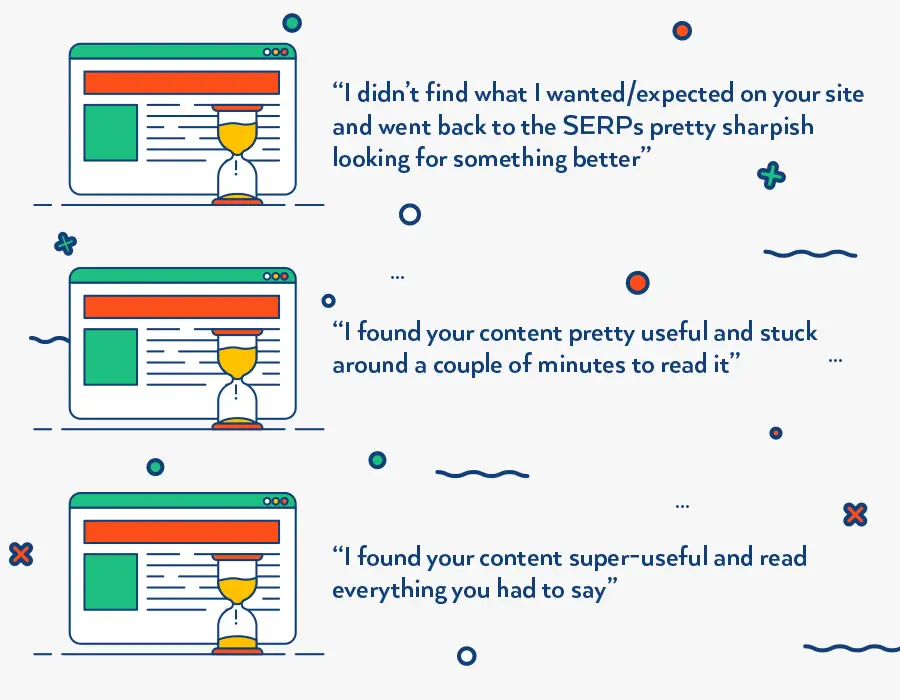
The better the Dwell Time, the better it is for ranking since a lot of SEO experts consider this as one of the ranking factors. However, there is no official statement from Google that they consider Dwell Time as a ranking factor but it seems it can help in ranking because Google has always been advocating that the pages offering a good user experience can perform better in search. And, if think about it, better Dwell time indicates that the user is having a good experience on a particular page because he is staying there.

It’s been a bit confusing to understand if the Dwell Time is a ranking factor or not. But, it is always good to have a better Dwell time because it indicates a good user experience actually. So, work to boost it for your pages.
You should know!
Dwell Time is a Good Indicator of Relevance i.e. Users’ Search Intent
Better Dwell Time also indicates that your pages are coming in search of relevant user intent. That means, your content is coming in search exactly when it should appear for search intent. At times, some pages come up on Google when you are not searching exactly that thing. So, if the Dwell time is good, that means your page is quite relevant to search intents which is a good indicator as well.
What is Search Intent?
A user’s search intent is the goal of finding something when he types in something into a Search Engine. For example, if I am searching “Leather shoes” that means I am not looking for an informational article rather I am looking for online stores to show leather shoes. For this search query, if I get some informational article saying how to care for your leather shoes? then obviously I will go back to search as my intent is to see the listings of such shoes on e-commerce sites so that I can check out and buy. That is why it is always said to prepare content keeping the user’s search intent into consideration.
If user intent is the same as your content provides, then automatically, your site’s dwell time will be better.
That is the reason, it is always advised to use relevant keywords to your content and not deceiving ones. Because, even if your content ranks for some deceiving keyword, users will find that not worthy when they land, and then they will go back which will hamper your site’s dwell time and time spent on the site as well. Which further leads to bad search ranking.
So, to boost Dwell time, you should consider these pointers:
- Write Exception Content: For any topic, you must research well, and do a lot of analysis, then write content that can give answers to every query for that particular topic. So, that readers won’t turn themselves away so soon. There the dwell time increases when they spend time reading your full article.
- Format and Present Beautifully: Just writing exceptional content may not be enough at times because the first impression you can have great if you have beautifully formatted content. Because, when someone lands on your page, the first thing he sees is how well the article is readable and easy to scan. So, making various color boxes, using beautiful bullets, making lists for sections, and other things could be useful to keep the user hooked to your page at the start, and then with the content quality, he will stay for even longer.
- Use Visual Content: Visual content tends to hold users for a bit longer as they seem to be easy to get at the first glance. So, making use of good graphic content and videos may help boost the Dwell time.
In short, do everything to your page that convinces the visitor to not go back so soon without reading the full content. And, this is what you have to think more about what all you can do. This is not just something I or anyone else will tell you because it is you who knows what kind of visitors you are getting to your site. Accordingly, you can plan content types, formatting, linking, graphics, videos, etc. to hold them for longer.
Note: Don’t confuse between, Dwell Time, Time spent on site, and bounce rate. They are different from each other.
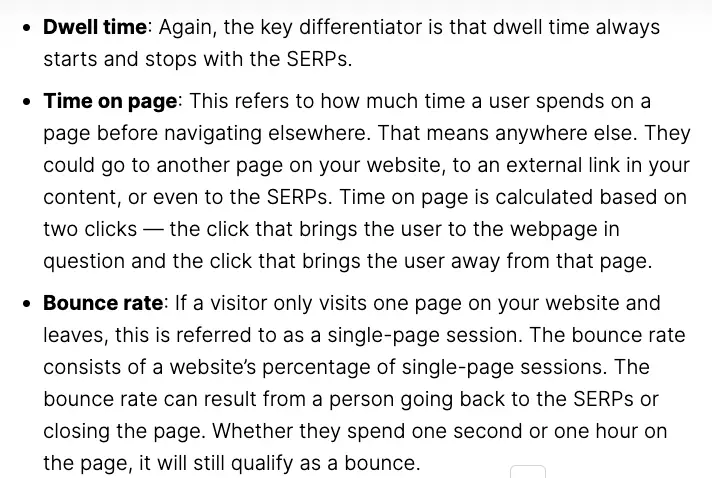
-
Add Outbound Links
In the past, we all have read that having good inbound links matter only. But, in this age of advanced level SEO, outbound links are also helpful for increasing your site’s ranking. yes, you heard it right. They do help if you link to relevant pages when necessary. If you are just linking out for the sake of having few outbound links, it may not offer good results. It can work out well when you link to pages that are relevant to what you are linking from.
Don’t afraid to link out, just do it cautiously and keeping the relevance in mind.
Few other things are there as well which you may also check out such as checking broken links [Read how to use broken link checker tool], checking robots.txt file, checking crawl errors using webmaster tools, and fix any issues if you get.
RankBrain!
RankBrain is Google’s search algorithm that uses AI, and it looks for the relationships and connections between words and phrases.
Thus, being a human, you can give the information accordingly that RankBrain could understand your content the way you want it should understand. This way, you can get a good ranking for many long-tail keywords.
Final words
On-page optimization is the very first step of your SEO campaign. You must not miss it because Google is now focusing more on on-site factors than off-site factors.
I am sure these tips are well enough to get started with on-site SEO. Share your views as what do you think about On-site SEO.


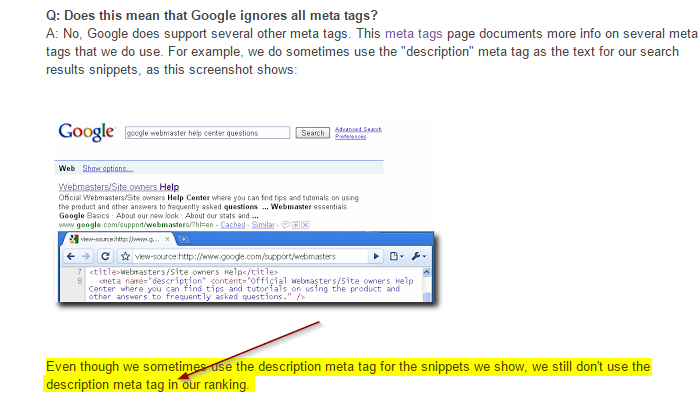

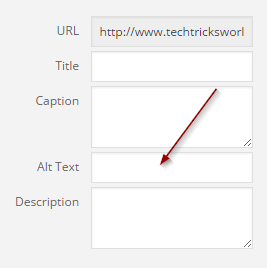





>Nice Info about on page
The age of domain name is also consider one of the key factor in ranking. Google prefer old domain names over new.
thanks Bilal for the valuable information.
although age of the domain plays a factor, more and more weight age will be given to quality content (not unique content according to Google panda algorithm)
You are right Raj
It is also required to have a good interlinking of pages among your site to get more and more pages indexed. Google webmaster tools also provide you the links which are availbale from your own pages and their count.
You should also consider that you do not have multiple pages with same title and description as they are treated as duplicate title.
Thanks Durgesh for the valueble information.
Very useful Information you have mentioned.
Thank you.
I apply most of these stuffs on my blog.. And one more thing delete all the not-so-useful pages from your blog so that it will help to reduce duplicate content.
Yes you are right . we should delete those pages which are not useful.
Thanks for the information, I just started my website and information like this really helps. Great information too
Durgesh Chaudhary :
“You should also consider that you do not have multiple pages with same title and description as they are treated as duplicate title.”
Definitely learned something new today.
Thanks For your comment Ron
Very good article, really helpful.
Thanks For your comment.
great post, many things to be modified on my website
Hi Atish. Thanks for the great tips- does it matter if your site title is more than 70 characters long?
Many thanks,
Simon
I don’t think this can be a problem but its good to have a short title with full meaning.
This is Also An Awesome Article On SEO. I Like Both Of Your Article Related to SEO Thanks
You are welcome. Its the basics only.
I would like to add one thing that is: Navigation. One should definitely take care about how the site pages have been navigated as this surely plays a very important role.
Yes You are right. thanks for this addition. navigation must be easy.
Can you please tell me how to give alt tags to images?
to put alt tag in images do as:-
img src=”image source here” alt=”your alt text here”
Put “<" "/>” in the start and end. Here i am writing separately because its getting visible in the comments.
OK…………….Thank You….Atish……..I will try it ……in the images I post
On page is a part of SEO which is very important first and main work of whole site because we can optimize our targeted keyword on title ,tag and description and webpage visible on majar search engines results
Thanks for sharing nice information
Seems, you know something about SEO already! Its alaways beneficial to have some knowledge about SEO if you are owner of one or more websites.
On-page optimization is one of the most crucial aspects of your SEO strategy. If done in the right way and also you have shared great information
Thanks for sharing
Thanks for coming by Priya. Glad you liked the post.
Thanks for the information, I am new to SEO. I am trying to provide good quality content. There are so many things I want to learn but don’t know where to start with. It would be really helpful if you provide me guidance.
thanks for the post…
Hey Tohota,
let me know what kind of help you want from me. If you read this post itself, you will get fair idea about the On page SEO at least.
Well explained. Thanks for the share.
Onpage Optimization is very important factor to help the website to rank high in the SERP. It is the very first step to start SEO promotion.
I would like to add few points along with the above mentioned points.
1. URL structure is also an important factor
2. you should also add user friendly files like robots.txt, sitemap.xml, index.txt to the website.
Hello Bruce,
I have mentioned about URL, where you read about permalink. I did mention about robots.txt file as well. Yes, I missed sitemap.xml (my bad), Glad you added it. Thanks for coming by.
Atish,
Good to know that you’ve worked on this old post to make it better.
I agree with the every on-page SEO point and I’ve learned all from you. Many bloggers make mistakes in H tags like they use H1>H2>H3>H2>H4 without following a sequential way. If I find any, I notify this mistake to that blog owner.
You’ve missed a word about using 2 -3 synonyms of the main keyword or LSI keywords. Otherwise, your edited post is perfect. Keep doing your great work and have a good day ahead!
Thanks for coming by Nirmala. Glad you liked it. I haven’t missed the point of adding Semantic, if you read the 5th point carefully, you will get to know that I have mentioned this too.
oh good! I’ve tried a lot to find anything was missing, but I can’t! You’re simply great and I’m speechless now!
Though I missed one thing, that is adding a sitemap.xml. However, one of the reader and commenter mentioned it in the comments. Thanks to him!
Thanks to you Atish. You are doing a great job.
Yeah, I’ve missed pointing out that you haven’t mentioned Sitemap.Xml here Atish. As Bruce said, you’re doing an excellent job in crafting this kind of post for us.
Thanks Bruce from my side 🙂
Very well explained Atish. Nowadays Mobile friendliness and website loading time is important to get ranked well in a search engine result page. Overall nice post.
Thanks for reading my post Kalpesh.
your Awesome and Nice blog…thanks for sharing…its very interesting…
mobile friendly design is also good for search engine optimization.mobile marketing is best way to promote your business and improve your profit.
your real vistor
Jahangeer Ahmed
Yes, having a mobile friendly design is good to get ranking in Google Mobile search.
Hi Atish,
Thank you very much for sharing this valuable and informative post.
Regards
Reji Stephenson
Glad you liked the post Reji.
Atish, again you did the awesome job here…!
I heard some bloggers said that SEO is dead, but I don’t think so. The SEO is one of important job that you should considering of.
You know..? If you did right way with SEO, you’ll get better performance of your online business even offline.
To take of on-page optimization is basic way to get starting with SEO. I love what you mention about responsive, it’s important of new search engine change; especially Google.
I found Google is focusing on quality content, thus to write longer length is great advice.
Oh, also I head Google is using conversion rate to identify the quality of content. So, to worry about loading speed much important for on-page optimization
thanks
Hello Kimsea,
SEO is not dead, and it will never be. Its just the way to do SEO has been changed! On-site SEO is now playing more important role than what Off page SEO does. Yes, conversion rate might be a measure to evaluate the site’s credibility.
Thanks for coming by.
Very useful information Atish, It is every blogger’s wish to get their blog and post listed in first page of google and SEO plays a key role in bringing your content visible to google search. You nicely explained about page speed and optimizing the image.
Regards
Mukesh
Thank you for coming by and reading the post Mukesh. On-page SEO is very important nowadays.
This is a comprehensive guide to SEO. The importance of Search Engine Optimization should be learned and understand by people who are into blogging and marketing online. A very valuable strategy, I must say.
SEO is vital because the real purpose of SEO is to help people who are looking for you find you.
Here in this article, you will learn how to craft your content with SEO strategy. One of the fundamentals is Keyword. Pick a keyword that will help bring people to your site and are relevant. Code optimization is also important.
Well, there are so many things you need to know when it comes to SEO yet it’s worth it. Additionally, it is always helpful to get additional input especially if you are your own SEO for your own page.
Hey Metz,
I am happy that you liked the content. SEO is one of the things which must not be missed by any online webmaster or blogger. Without SEO, its tough to rank better in Search engines.
Outsourcing SEO doesn’t work nowadays because most of the times you don’t get desired results for the money you spent, doing it on your own is tough at first, but as you learn it gradually, you can do it.
Thanks for reading my post Metz.
Hi Atish,
Indeed, these are great tips for on-page SEO optimization. A lot of bloggers/Internet marketers miss out on the benefits of this process.
Its easy to implement and it takes consistent application to propel a blog/website into achieving traffic generation with On-page Optimization of the search engine.
Its cool to learn of the basics of On-page optimization here. Newbies as well as experts will surely take advantage of this site!
I left the above comment in kingged.com
Hello Sunday, Thanks for coming to my blog and reading this SEO post. SEO has always something new to give us to learn and research. That’s why I love SEO.
Hi Atish Ranjan,
Just founded your great blog post and it’s my first comment!
Yes, on page SEO is the base of a blog or websites. If we make any wrong doing on page seo then it can hurt our SERPs ranking. By proper on page optimization we can able to get good position on the SERPs.
I have written a similar article about on page optimization on my blog. Here i described the best on page seo what every blogger should follow!
However, well written detailed article. Thanks for sharing an informative post with us.
Would love to see your comment on my blog too! Will you Atish Ranjan?
Happy blogging!
Thanks for the comment Minhaj. I will read your post and comment for sure.
Hi Atish,
You did a very good job and provide very valuable stuff in this post.To get good ranking on search engines there are lots of factor responsible like social media appearance, quality content, off page optimization and also on page optimization. If we not doing good on page optimization its effect our website ranking.
In your post you explain everything in very descriptive way. and all the information are very useful.Thanks for sharing.
I am happy that you liked the post Laxmi. Keep supporting via your good comments.
yes, these tips are really actionable in onpage seo, particularly url structure. It’s very important to get good ranking for that specific page in search engeines, Thank you for sharing..
Hi, Atish,
Thank you so much for providing the basics of on-page optimization. This is really helpful because it’s simple, yet lays the foundation for the fundamentals of SEO.
I’m glad you mentioned image optimization because that is a topic that is near and dear to my heart. As you know, ever since finding out that I can rank for my images I have tried my very best to always use unique and original images on every single blog posts. For me, it’s important that the image passes the TinEye.com test, so that’s a step farther to ensure optimization.
I test my site speed about once per month, and I see that I have some things to adjust… as we add content and tweak our blogs on a regular basis, things crop up the didn’t use to be there. This is the case with my site right now, so thanks for the reminder.
I’ll be sharing this with friends, I think it’s great information.:-)
Have a great rest of the day. Talk soon.
Carol Amato
Hello Carol,
Thanks for reading and liking my post on On page SEO. yes, its simple yet the foundation of SEO. Image optimization is what often ignored by many thus a little less competition is there.
Many a time, your post doesn’t rank in web search but rank well in image search if you properly optimized the images.
You are doing good job by testing the loading speed regularly.
Hi Atish,
Valuable tips here for starters. I must say that image optimization is what I would go for if I have some product oriented business. Having them in searches in search engines will be a delighted moment as this way I can drive more traffic. Also, having a separate image sitemap is also a good idea. What you think?
Am so glad i found this post. Atlast i found someone that agree with me that on-page seo is very important. Without proper on-page seo, off-page seo won’t pay off.Thanks once again for this awesome post.
Site speed is very important but should we go for a vps from starting or a shared server is ok? Does it have a negative influence if I use a shared hosting?
It’s all about budget Fiana. if you can afford, VPS is much better than Shared.
Hi Atish,
You have made SEO so easy to follow in this post. Although I’m always struggling with my headlines, I have been on point with my Title tags and meta descriptions. I have seen a huge difference since I have been doing that.
I also am paying attention my my H1, 2 and so forth.
Glad you mentioned images because I do find that being one of the most important factors. My images have been appearing on Google Images and I’ve been getting some nice response.
These are valuable tips and you know I will share!
-Donna
Hello Donna,
I am so happy that you liked the write-up. Though, I am well aware of SEO I have been neglecting it because of laziness. But I have started focusing on SEO now again.
Thanks for the very kind visit Donna.
Hey Atish
Good share about onpage optimization which I’ve not used internal linking but with my friends reference found usefulness of that method and found some changes in results too.We should always give some preference for site speed also rest things normal thing we do between nice share for bloggers and people are in startup.
Hi Atish
That’s a really useful post, with extra value added by the comments. It’s good to see the basic of SEO explained so well in one place.
I also use the free WordPress SEO plugin by Yoast to help me improve my SEO.
I’m still not consistent with my Alt Text for images, but I’m trying harder!
Thanks for the info.
Joy
Loading time and Mobile responsiveness don’t fall under on page seo ,they are part of off page seo.
Is it?
As far as I know, off page SEO includes those strategies which are done off the site that means nothing on the site, and when it comes to loading time and mobile responsiveness, we need to make changes on the site, so at least, I consider them under On page SEO.
Thanks for your views Rachit.
Thanks For sharing your blog really very helpful…and there is lot of information in your article…Nice work..
Hi there, excellent post.
One thing to add to perfect permalink struture. I’ve read somewhere (don’t remember where, anymore), that every slash behind word brings additional 16 more difficulties to rank with post higher then post without slashes. So, I follow this rule all the time, altough don’t know if it still helps or not. Regards, Matija, Slovenia
Yes, Matija,
As many slashes you are having in your permalink, the difficulty to rank increases. Thanks for add up. I missed to include it in the article.
Hi Atish,
This post is really very nice and informational.I got many new things from it.Its really very useful.I am new in SEO field and it clears my most of doubts about on page optimization. But Could you please help me out how to get permalink in blogger.
Thanks
Hello Saurabh,
I am not much aware about blogger hacks, but now they do give the option of custom permalink though you cannot remove the year/month. You can edit the later parts of the permalink. let me know if you don’t find it.
Thanks for reading my post Mate.
Hello Atish,
I am regular visitor of your blog. I really like this article. On page factors play key role in website success. All the factors are very important for a site success, but I think content is the most imortant on page factor. A website with good content can become even better with SEO.
Thanks for sharing this article.
Have a great day!
Agree with you Pawan!
Content is important and the most important thing.
Hi Atish,
Really great information on – On Page SEO – Atish.
Very many Bloggers till today, do not make use of the built-in facility in WordPress to deliver human friendly URLs which are the SEO friendly permalinks.
Often this is just due to ignorance or an aversion to all things tech, but when any Blogger takes the trouble to setup their WordPress driven Blogsite to deliver SEO friendly permalinks there is a huge value added to the blog site.
Ensuring that the Title tag contains your keywords naturally is another bit of sound advice. Ensuring that the blog post – Title – (content appearing within the ) is the same as that in the tag is adds value as well.
While Google has stopped looking at Keywords and Description as a ranking factor several years ago, having a well written, engaging Description is valuable. Google often using the content available in Description within its search engine results page.
This information is what the seeker sees first within the SERP. It’s the reason why they may click your link in the SERP rather than another one. Hence a well written and engaging Description adds real value to any webpage or Blog post.
Wow! you’ve really explained content optimization for SEO well. Great job.
Page load speed and Responsiveness are two really important SEO attributes that Google has been shouting about for quite some time. It would be really short sighted to ignore these page / Blog post attributes.
Thanks for this really well written and detailed Blog post Atish. It was a great read.
I came to you site from a linked on Kingged.com
Ivan,
You made my day by writing the comment in so detail. Yes, the things you have mentioned and you have read in this article are very important for SEO.
Thanks for reading and commenting here!
Hello Atish..
Thanks for giving your valuable suggestions to us on SEO. I am doing SEO to our sites , so this article is very useful to me. you have explained clearly how to do and how to follow the rules in on-page and off-page SEO.
Thanks for liking my blog post Siva.
Good tips overall Atish.
Nailing the basics is key with any SEO work. Having a stable foundation is the best thing to start with. Keep up the good work!
Hey Dennis,
Thanks. yes, If your base is strong you can do wonders in SEO.
Well said Atish. One can do wonders in SEO. What required is to make the base strong and stay update to latest trends and tricks.
Hi Atish,
What a wonderful blog post on on-page SEO.
I am fairly new to this and haven’t given SEO much thought, but I see how important it is now. I have much to learn from you
I didn’t know who you were until a little over a week ago and I am glad for blog commenting because that is how I met you.
Thank you for the great blog post.
You have a wonderful weekend.
Linda
Hey Linda,
Thank you so much for reading my post and sharing your thought via comment.
Sure, you can ask any question anytime! I will try to answer you with the best solution.
Yes, blog commenting is indeed cool! 🙂
Enjoy the weekend.
Thanks frend for sharing this information . i hav cleared my doubt for on page optimization. i understand all this think u describe. one thing how to increse google page rank for my blog. plz tel me
Google page rank is dead. Google has stopped updating PR.
why
Atish,
Very Very useful tips. Meta description and image optimization are those which most of the bloggers would miss. I got this today from your blog. Thanks.
This is a great article for on page optimization. It helps me lot to know how to do on page optimization.
Great post. Thanks for sharing with us.
Hello Atish,
You have explained all things clearly. With this article a newbie can also learn a lot of things about ON page optimization. Keep up the good work !
That’s a great article for newbie. I have one doubt regarding using tags in articles. Do you think they add value from SEO point of view? I have read many mixed reactions on this topic and found some bloggers not at all using tags and few are using massive way.
Hello Santanu,
If you are talking about WordPress tags then I would say yes, if you use 2-3 then it is fine, and many times you will see the tag page ranks better than the article link. You can make use of it by putting good keywords as tags. But, if you add so many tags, it may hamper your blog because as many tag you create, a new page is added. So, for same content if you have 10 links(if you have added 10 tags), same content will be there, and that will lead to Plagiarism.
Use 2 or 3 only!
Great post. Thanks for sharing with us .
This is a great article for on page optimization. It helps me lot to know how to do on page optimization :).
You have explained all things clearly. With this article a newbie can also learn a lot of things about ON page optimization. Keep up the good work !
Now, this is why I enjoy visiting other marketing blogs — I knew most of what you reveal here, Atish, BUT I learned some new things as well. And, you have a different perspective on things.
Very comprehensive post about on-page optimization. Thank you so much for sharing your wisdom!
Deborah
Glad you liked the post, Deborah.
Keep visiting.
Hi Atish,
excellent post!
Do you think that adding the keyword in the first 100 words of the content still works?
Hello Erik,
Although it is an old post, I am sure that adding the keyword in first 100 words work out well because the keyword indicates your main topic, and when you have that keyword in the beginning, Google gets it well as what the topic is all about. So, yes, it should be a good SEO practice still in this year.
Thanks for the comment, mate.
Hi Atish,
This is one of the extensive and more in-depth articles on this topic. I started blogging in 2015 and still, I am struggling to get proficient in SEO. This article is very easy to read, understand and informative for every beginner blogger as well as people like me. Thanks for sharing this article and the point like “boost dwell time” is something new to me.
Thanks for writing in, Gurunath. I am happy that it is helpful to you.
Such an great informative article. Keep the good work up, Waiting for your newer updates
Thank you for the useful information which you shared throughout your blog. I appreciate the way you shared the relevant, precious, and perfect information.
Hello Atish,
It’s good that you have modified this post with the latest information. I love to do on-page SEO and reach the target audience by ranking on top. Thanks for updating this post.
Hello Nirmala,
Thanks for commenting again on this post. Yes, On-page is backbone of SEO which is often neglected by many.
Hi Atish,
All of your On-Page points are brilliantly defined with proper examples in the post, using very simple language. Yes, you are right Google considers On-Page as a major ranking factor then off-page. So, it’s important to check all the checklists that you have mentioned in this post. Also, I am very much impressed with your website page speed. Awesome!!!
Thank you for updating the post and sharing such an informative with us.
Glad you liked it, Anoop. Thanks for coming by.